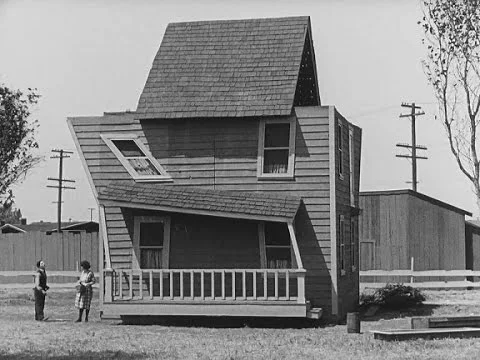Buster Keaton's One Week
Published back in 2009 in Design and Culture, the journal of the Design Studies Forum.
What film features the best prop in the history of cinema?
My vote goes to Buster Keaton’s 1920 two-reeler One Week, twenty minutes of surpassing genius starring the silent film comedian, Sibyl Seely (as Keaton’s young wife), and a house, which is the prop in question.
The plot runs as follows: Keaton and Seely get married, and are given a plot of land and a prefabricated house, very much the coming thing in 1920. Keaton’s wicked rival Handy Hank (identified as “the fellow she turned down,” all the exposition one wants really) sneaks on to the lot, sees the house lying in its boxes, and renumbers the parts. The result is that the building, once erected the next day, looks like something out of The Cabinet of Dr. Caligari, or perhaps an Analytic Cubist painting.
Buster Keaton, One Week, 1920.
It’s a good candidate for the most radical American house of the early twentieth century: the front door is on the second floor, the porch and windows tilt at rakish angles, and the kitchen sink revolves for easy access from the exterior. What’s more, the prefab parts prove to be interchangeable, so that when Keaton needs to scoot up to the roof, he plucks the porch railing off and turns it upright: instant ladder. Elsewhere in the film, he cuts a carpet into a welcome mat, uses a broom as a step stool, and wears a chimney. It’s as if Marx’s ideas about the fluidity of commodities were being played out before our eyes.
Buster Keaton, The Scarecrow, 1920.
Modern domesticity was a vein of comedy that Keaton also mined in The Scarecrow, an equally compelling film of the same year. It begins with a scene of all-male domestic ménage. Keaton and his large, comedy-mustachioed roommate (played by Joe Roberts) sit down to a breakfast in which every condiment is suspended from the ceiling on cords, which they swing to and fro for maximum efficiency. The Scarecrow also features a phonograph that turns into a gas stove, a bed that turns into a stand-up piano, and another astounding prop: a dining tabletop that can be removed with the dishes still attached, hung on the wall for easy hosing off, and finally flipped over to reveal a decorated sign reading “what is a home without a mother?” As a commentary on modern domestic science, all this strikes me as more eloquent than a hundred pages of Christine Frederick.
Buster Keaton, One Week, 1920.
Back to One Week now for the climactic scene, in which the house and its hapless owners are caught in a freak storm. Through the use of a massive turntable on the studio lot, the building is made to spin like a merry-go-round. Keaton, caught outdoors in the tempest, has a good deal of trouble aiming for the door as it races around. When he finally gets inside, he is sent careening around the living room – a dance-like whirl of such beauty that it is best appreciated frame by frame. The morning after, the house is even more avant-garde in appearance than it was to begin with (“now look at the darn thing!” exclaims Seely’s character). To make matters worse the young couple are told that they must move the whole house to another lot, which is literally on the wrong side of the railroad tracks. They make the portable house portable once more, mounting it on four barrels at the corners and hitching it to their Model T, but they don’t get far – the house gets stuck on the rails. The culminating gag should not be disclosed here. Suffice to say that the house dies a spectacular death at the hands of the technological sublime.
Incredibly, given its high-as-a-kite concept and extravagant production values, One Week was the first feature that Keaton ever released. It inaugurated a career of films in which designed objects and settings were used ostensibly for comic value, but in ways that pin down their cultural valence with astonishing precision. If there is no more pleasurable way for a design historian to approach the subject of mass-produced housing than through Keaton, then the same could be said for vaudeville (The Playhouse, 1921), the electrification of the domestic interior (The Electric House, 1922), the luxury yacht (The Navigator, 1924), civil war-era trains (The General, 1927), and even the physicality of film itself (Sherlock Jr., 1924). It’s no wonder that he was among the Surrealists’ favorite moviemakers. Operating in a quintessentially modern medium, the unassuming Keaton gave us the most concise statements of the absurdity that modernity itself brings about. Walter Benjamin said it best: these films are works of art for an age of mechanical reproduction.


